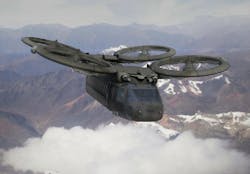Navy considers ship-based, long-range Marine Corps UAV for EW, cargo, and reconnaissance
PATUXENT RIVER NAS, Md. — U.S. Navy and Marine Corps aviation experts are thinking about a future ship-based multi-mission unmanned aerial vehicle (UAV) able to operate at extended range and endurance that could be operational as early as 2028.
Navy and Marine Corps leaders are considering a future unmanned aircraft for battlespace awareness, electronic warfare, battle management, logistics, and fire support.
Officials of the Naval Air Systems Command at Patuxent River Naval Air Station, Md., have issued a request for information (N00019-18-NORFP-PMA-266-0126) for the Marine Air Ground Task Force (MAGTF) Unmanned Aircraft System (UAS) Expeditionary (MUX) project.
Experts are interested in the future MUX unmanned helicopter or tiltrotor for battlespace awareness; electronic warfare (EW); command, control, communications, and computers (C4); logistics; and fire support to complement the Marine Corps manned MV-22 tiltrotor, F-35B fighter-bomber, and Future Vertical Lift (FLV) cargo aircraft.
Marine Corps leaders intend the future MUX unmanned aircraft to have an unrefueled combat radius with payload of 350 to 700 nautical miles; cruise speeds between 200 and 300 knots; time on station of 8 to 12 hours; internal payload capability of 3,000 pounds; external payload capability of 3,000 to 9,000 pounds; and the abilities to operate from ships and austere fields, to receive aerial refueling, to operate in all weather, and to operate in national air space.
The MUX should be able to handle early-warning missions and support over-the-horizon networked identification, cueing, and defense against enemy aircraft, cruise missiles, and indirect fires. It also should be able to handle long-range, wide-area persistent air reconnaissance and surveillance while providing overlapping and cross-cued data from several different sensors.
This unmanned aircraft should be able to conduct long range penetrating airborne electro-magnetic spectrum operations against threats in the air, on land, on the ocean, and in cyberspace. Navy and Marine Corps leaders also want this aircraft to handle communications relay, aerial escort, and transport cargo.
The MUX should be able to fly autonomously from start-up to return from amphibious assault ships — including en-route flight, conducting missions, and operating from austere landing fields. This will involve supervisory control and full autonomy.
Companies interested should send responses no later than 7 May 2018 to the Navy’s Bradley Lysaght at Building 441 Room 117, 21983 Bundy Road, Patuxent River, MD 20670-1547, with electronic copies to [email protected] and [email protected].
More information is online at https://www.fbo.gov/spg/DON/NAVAIR/N00019/N00019-18-NORFP-PMA-266-0126/listing.html.

